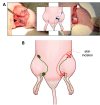The effects of postoperative treadmill exercise on rats with secondary lymphedema
- PMID: 37220160
- PMCID: PMC10204966
- DOI: 10.1371/journal.pone.0285384
The effects of postoperative treadmill exercise on rats with secondary lymphedema
Abstract
Cancer-related lymphedema (LE) is often caused by radiotherapy and surgery such as lymph node dissection (LND). Previous studies have reported that exercise is beneficial to relieve LE, but the changes in the lymphatic system following exercise are still unclear. This study aimed to examine the changes in lymphatic drainage pathways over the exercise period and beneficial effects of exercise in rats with LE. Twelve rats were randomly allocated into exercise and control groups (EG and CG; n = 6 each). To obtain LE, inguinal and popliteal LND followed by 20 Gy irradiation was performed. Treadmill exercise was 30 minutes/day, 5 days/week over the four-week period. Consecutive indocyanine green (ICG) lymphography images were collected and classified into five patterns: i) linear; ii) splash; iii) stardust; iv) diffuse, and v) none. Ankle thickness was measured weekly. Histopathological evaluation was performed to examine the skin thickness, collagen area fraction (%) and lymphatic vessel density in harvested tissue. ICG lymphography exhibited more linear and splash patterns in the EG at week 3. The difference of swelling between both groups was significantly different at week 4 (p = 0.016). Histopathologic data revealed a thinner epidermis (p = 0.041) and dermis (p = 0.002), lower collagen area fraction (%, p = 0.002), and higher lymph vessel density (p = 0.002) in the EG than the CG. In conclusion, we found that postoperative exercise can facilitate improvement in lymphatic fluid retention in the lymphedema rat model, resulting in improvement of pathological conditions in the lymphatic system.
Copyright: © 2023 Kim et al. This is an open access article distributed under the terms of the Creative Commons Attribution License, which permits unrestricted use, distribution, and reproduction in any medium, provided the original author and source are credited.
Conflict of interest statement
The authors have declared that no competing interests exist.
Figures



Similar articles
-
Correlation between indocyanine green (ICG) patterns and real-time elastography images in lower extremity lymphedema patients.J Plast Reconstr Aesthet Surg. 2015 Nov;68(11):1592-9. doi: 10.1016/j.bjps.2015.06.027. Epub 2015 Jul 6. J Plast Reconstr Aesthet Surg. 2015. PMID: 26239375
-
Lymphatic anatomy of the inguinal region in aid of vascularized lymph node flap harvesting.J Plast Reconstr Aesthet Surg. 2015 Mar;68(3):419-27. doi: 10.1016/j.bjps.2014.10.047. Epub 2014 Nov 11. J Plast Reconstr Aesthet Surg. 2015. PMID: 25465766
-
Personalizing Conservative Lymphedema Management Using Indocyanine Green-Guided Manual Lymphatic Drainage.Lymphat Res Biol. 2021 Feb;19(1):56-65. doi: 10.1089/lrb.2020.0090. Epub 2020 Dec 2. Lymphat Res Biol. 2021. PMID: 33270517
-
Indocyanine Green Lymphography Findings in Limb Lymphedema.J Reconstr Microsurg. 2016 Jan;32(1):72-9. doi: 10.1055/s-0035-1564608. Epub 2015 Sep 30. J Reconstr Microsurg. 2016. PMID: 26422172 Review.
-
Patterns of lymphatic drainage after axillary node dissection impact arm lymphoedema severity: A review of animal and clinical imaging studies.Surg Oncol. 2018 Dec;27(4):743-750. doi: 10.1016/j.suronc.2018.10.006. Epub 2018 Oct 12. Surg Oncol. 2018. PMID: 30449502 Review.
Cited by
-
Ultrasonographic features of the skin and subcutis: correlations with the severity of breast cancer-related lymphedema.Ultrasonography. 2024 Jul;43(4):284-293. doi: 10.14366/usg.24059. Epub 2024 May 31. Ultrasonography. 2024. PMID: 38881309 Free PMC article.
-
Brain alterations and neurologic disorder progression induced by lymphatic dysfunction in the head and neck region.Acta Neuropathol Commun. 2025 Apr 8;13(1):72. doi: 10.1186/s40478-025-01953-w. Acta Neuropathol Commun. 2025. PMID: 40200314 Free PMC article.
-
The role of exercise in promoting lymphangiogenesis and extracellular matrix synthesis in lymphedema-induced tissue injury.Mol Biol Rep. 2024 Dec 16;52(1):50. doi: 10.1007/s11033-024-10149-9. Mol Biol Rep. 2024. PMID: 39676093
References
Publication types
MeSH terms
Substances
LinkOut - more resources
Full Text Sources
Medical

